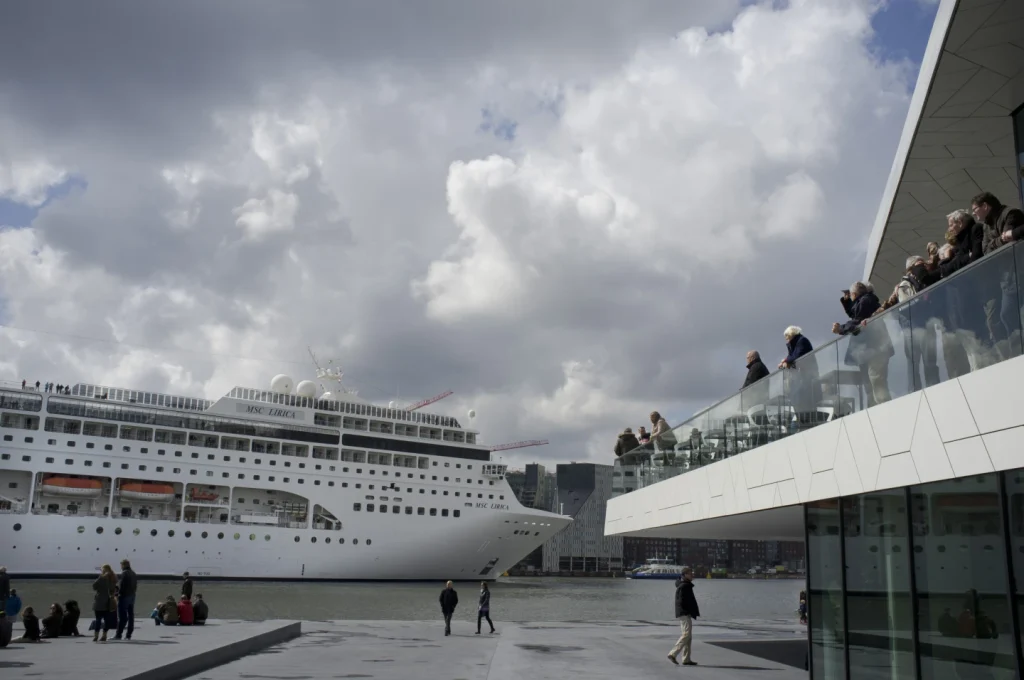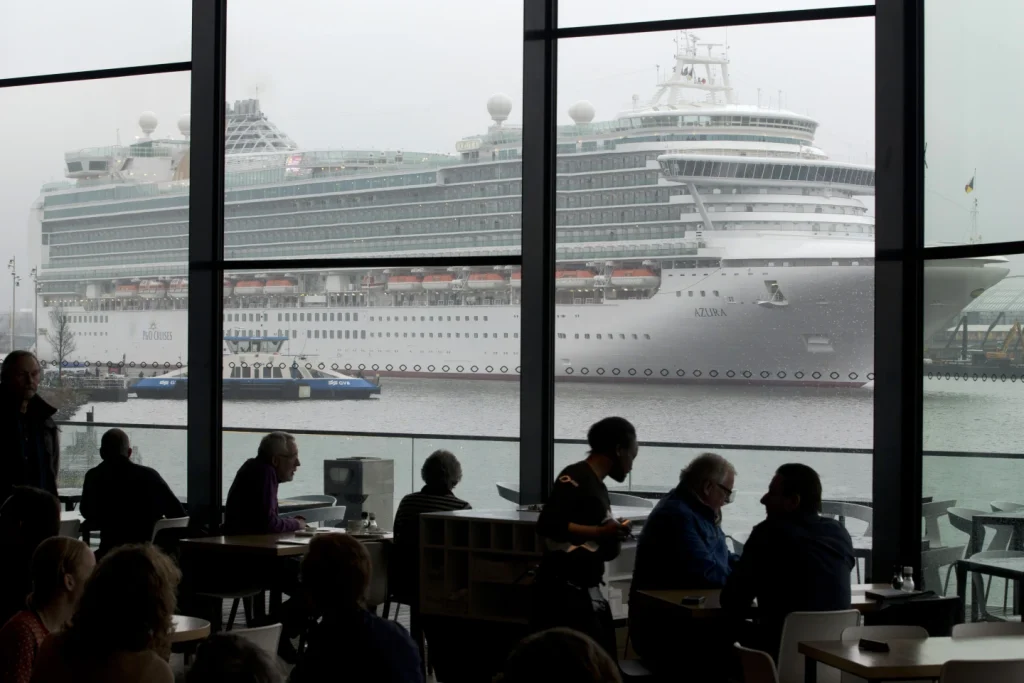Amsterdam, known for its iconic canals and vibrant city center, has taken a bold step in an effort to reduce ship mooring and alleviate the strain it puts on the city.
The decision to relocate the ship terminal away from the bustling city center has caused a significant blow to the tourism industry, as tourists flock to the city to experience the charm of its historic canals firsthand.
The move to relocate the ship terminal stems from the city’s ongoing efforts to balance the needs of its residents with the increasing demands of tourism.
The constant presence of large ships docking in the heart of the city has created congestion and disrupted the local mobility.
In an attempt to address these concerns, Amsterdam believes that relocating the terminal to a different area will not only reduce the strain on the city center but also provide visitors with a more enjoyable and authentic experience.
However, this decision has not come without consequences. The relocation has dealt a significant blow to the tourism industry in Amsterdam, as tourists are drawn to the city’s vibrant city center and its unique charm.
The iconic sights, such as the Anne Frank House and the Rijksmuseum, have long been part of the allure of Amsterdam, attracting millions of visitors each year.
The relocation of the ship terminal further away from these attractions is expected to deter some tourists from making the journey to Amsterdam, impacting the local economy and businesses that heavily rely on tourism.
Additionally, the move has also raised concerns among local businesses that depend on the footfall generated by cruise ship passengers.
The influx of tourists has been a boon for restaurants, shops, and other establishments in the city center.
With the relocation of the ship terminal, there is a legitimate fear among these businesses that they will experience a significant decline in customer traffic, potentially leading to financial difficulties and staff layoffs.
While the decision to relocate the ship terminal away from the city center may have been made with good intentions, the blow to the tourism industry cannot be ignored.
Striking a balance between the needs of residents and the demands of tourism is undoubtedly a complex task.
The city of Amsterdam will need to find innovative strategies to mitigate the negative impact on tourism, potentially by promoting alternative attractions, improving transportation links to the new terminal, or offering incentives for tourists to explore other parts of the city.
In conclusion, Amsterdam’s attempt to reduce ship mooring by relocating the terminal away from the city center has dealt a significant blow to the tourism industry.
While the move aims to alleviate congestion and improve the overall experience for residents, it has raised concerns for businesses and may deter tourists from visiting the city.
Finding a delicate balance between the needs of residents and the demands of tourism will be crucial for Amsterdam to navigate this challenging situation and ensure a sustainable future for both its residents and visitors.
The Dutch capital, Amsterdam, like many other captivating European cities such as Rome, Venice, and Paris, finds itself confronted with the challenge of handling the surging influx of visitors.
This surge in tourist numbers can be attributed to the gradual recovery from the aftermath of shutdowns during the COVID-19 pandemic.
To address this issue, the aldermen at Amsterdam’s municipality convened and voted in favor of a motion on Thursday.
The motion aims to urge the city to relocate the terminal, which is currently situated in close proximity to the central rail station.
This decision reflects the authorities’ proactive approach towards managing the overwhelming number of visitors and ensuring a sustainable balance between tourism and the preservation of the city’s unique charm.
Amsterdam, renowned for its picturesque beauty and cultural significance, attracts millions of tourists every year.
However, the recent surge in visitor numbers has raised concerns about overcrowding, strain on infrastructure, and the negative impact on both residents and the city’s architectural heritage.
As a result, the decision to move the terminal highlights the city’s commitment to addressing these challenges and finding innovative solutions.
By relocating the terminal, Amsterdam’s municipality aims to disperse the crowds, alleviate the strain on the central rail station, and distribute tourist footfall more evenly.
This strategic move could potentially lead to a more harmonious coexistence between tourists and locals, granting both groups the opportunity to appreciate and enjoy the city’s offerings without compromising its integrity.
This resolution also underlines the recognition of the importance of sustainable and responsible tourism.
By strategically managing the visitor numbers, Amsterdam seeks to maintain its appeal as an attractive destination while simultaneously preserving its cultural heritage, architectural treasures, and the well-being of its residents.
Ultimately, this decision by the aldermen showcases Amsterdam’s commitment to creating a balanced and inclusive environment, where the charms of the city can be shared and enjoyed by visitors from all over the world, while also respecting the needs and interests of its local community.
Through proactive measures and careful planning, the Dutch capital is poised to navigate the challenges of an ever-growing tourism industry in a manner that is both economically beneficial and socially responsible.
“A firm decision has been reached by the council regarding the relocation of the cruise terminal,” stated Ilana Rooderkerk, leader of Amsterdam’s centrist D66 party, in an email response to The Associated Press on Friday. “The municipal executive of Amsterdam is now tasked with devising a plan for its implementation.
Regardless, our stance remains the same: large ships will no longer dock in the city center of Amsterdam.”
Dick de Graaff, the director of Cruise Port Amsterdam, which operates the terminal in the city center, acknowledged the council’s decision and is awaiting further action from the municipality.
“While there are no immediate plans to close the terminal, the council’s directive is to relocate it.
We are eagerly awaiting instructions from the alderman for the necessary investigations,” he explained in an email response.
According to De Graaff, the Amsterdam terminal foresees 114 ships making a stop this year, with an expected increase to 130 ships next year.
This recent vote is just one of the many progressive steps taken by the Dutch capital to mitigate the adverse effects of tourism on the city.
In addition to this development, other measures have been implemented, such as prohibiting the consumption of marijuana in the narrow streets of the red light district.
Furthermore, there is a proposal underway to relocate several windows where provocatively dressed sex workers often stand, aiming to shift them away from the city center.
The commitment to reducing the impact of tourism is exemplified by Amsterdam’s recent “Stay Away” campaign.

Launched earlier this year, this initiative aims to deter what the city characterizes as nuisance tourism.
Through these various efforts, Amsterdam is displaying its dedication to maintaining a balance between attracting visitors and preserving the unique charm and cultural integrity of the city.
Visitors will always be welcomed to our city, however, if they misbehave and create disturbances, we as a city will have to take measures and kindly request them to refrain from coming.
This statement was made by Deputy Mayor Sofyan Mbarki, emphasizing the importance of respecting our city’s peace and tranquility.
But for Rooderkerk, the decision to ban cruise ships goes beyond just managing tourism. It is a reflection of our city’s commitment to sustainable development.
“The polluting nature of cruise ships contradicts the sustainable goals we have set for our city,” she expressed on Twitter following the vote.
With this decision, we aim to align our city with eco-friendly practices and ensure a sustainable future for our community.
She mentioned that the presence of towering cruise ships sailing into Amsterdam impedes the construction of a second bridge over the waterway, which would connect the city with its rapidly expanding northern suburbs.
Moreover, it should be noted that cruise liners are not the sole mode of transportation encountering limitations in Amsterdam.
The national government has recently declared its intentions to reduce the number of flights at Schiphol Airport, a bustling aviation hub that caters to the city’s needs.
